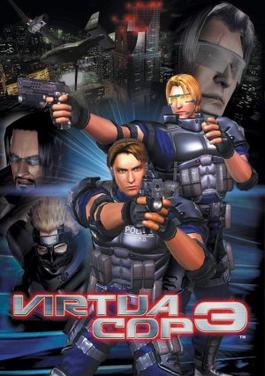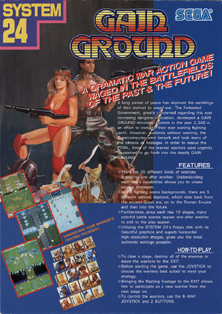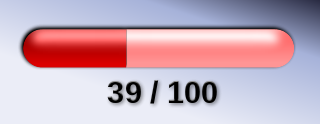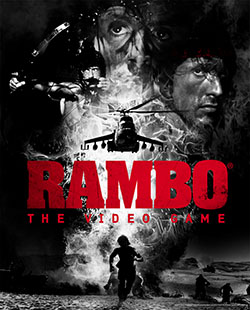
Radiant Silvergun is a shoot 'em up video game developed and published by Treasure. It was originally released in Japanese arcades in 1998 and subsequently ported to the Sega Saturn later that year. The story follows a team of fighter pilots in the far future who are battling waves of enemies summoned by a mysterious crystal dug up from the Earth. The player hosts an arsenal of six different types of shots to choose from, and a sword to destroy nearby targets. The stages are tightly designed to present players with scenarios that can be approached differently with the various weapon types.

In video games, a boss is a significantly powerful non-player character created as an opponent to players. A fight with a boss character is commonly referred to as a boss battle or boss fight. Bosses are generally far stronger than other opponents the players have faced up to that point in a game. Boss battles are generally seen at climax points of particular sections of games, such as at the end of a level or stage or guarding a specific objective. A miniboss is a boss weaker or less significant than the main boss in the same area or level, though usually more powerful than the standard opponents and often fought alongside them. A superboss is generally much more powerful than the bosses encountered as part of the main game's plot and is often an optional encounter. A final boss is often the main antagonist of a game's story and the defeat of that character usually provides a positive conclusion to the game. A boss rush is a stage where players face multiple previous bosses again in succession.
Shoot 'em ups are a sub-genre of action games. There is no consensus as to which design elements compose a shoot 'em up; some restrict the definition to games featuring spacecraft and certain types of character movement, while others allow a broader definition including characters on foot and a variety of perspectives.
An action game is a video game genre that emphasizes physical challenges, including hand–eye coordination and reaction time. The genre includes a large variety of sub-genres, such as fighting games, beat 'em ups, shooter games, rhythm games and platform games. Multiplayer online battle arena and some real-time strategy games are also considered action games.

Ikari Warriors, known as Ikari in Japan, is a vertically scrolling run and gun video game released for arcades by SNK in 1986. It was published in North America by Tradewest. At the time there were many Commando clones on the market. What distinguished Ikari Warriors were rotary joysticks and a two-player cooperative mode. The rotary joystick controls were in turn based on SNK's earlier TNK III (1985). Ikari was originally intended to be an official licensed adaptation of the film Rambo: First Blood Part II (1985), but SNK were initially unable to acquire the rights to the film.

Kung-Fu Master, known as Spartan X in Japan, is a side-scrolling beat 'em up developed by Irem as an arcade video game in 1984, and distributed by Data East in North America. Designed by Takashi Nishiyama, the game was based on Hong Kong martial arts films. It is a loose adaptation of the Jackie Chan, Sammo Hung, and Yuen Biao film Wheels on Meals (1984), called Spartan X in Japan, with the protagonist Thomas named after Jackie Chan's character in the film. The game is also heavily inspired by the Bruce Lee film Game of Death (1972), which was the basis for the game's concept. Nishiyama, who had previously designed the side-scrolling shooter Moon Patrol (1982), combined fighting elements with a shoot 'em up gameplay rhythm. Irem and Data East exported the game to the West without the Spartan X license.

Operation Wolf is a light gun shooter arcade game developed by Taito and released in 1987. It was ported to many home systems.

Sunset Riders is a side-scrolling run and gun video game developed and released by Konami as an arcade video game in 1991. It is set in the American Old West, where the player(s) take control of bounty hunters who are seeking the rewards offered for various criminals.

The Revenge of Shinobi, released in Japan as The Super Shinobi, is a hack-and-slash action video game developed and published by Sega in 1989. It was the first Shinobi game developed for the Sega Genesis, and was later released on the coin-operated version of that console, the Mega-Tech.

Virtua Cop 3 is the third and final game installment from Sega's Virtua Cop light gun shooter franchise, and released exclusively for video arcades in 2003. The game is available in standard and deluxe cabinet formats and runs on Sega Chihiro arcade hardware. A port for the Xbox was planned, but later cancelled.

Die Hard Arcade, known as Dynamite Deka in Japan, is an arcade beat 'em up video game released by Sega. It was the first beat 'em up to use texture-mapped 3D polygon graphics, and used a sophisticated move set by contemporary beat 'em up standards, often being likened to a fighting game in this respect. It also features quick time events, the ability to combine items to make more powerful weapons, and in two-player mode the ability to perform combined special moves and combos.

Gain Ground is an action game with strategy elements released as an arcade video game by Sega in 1988. It was ported to the Master System, Mega Drive/Genesis, and TurboGrafx-CD.

The House of the Dead 4 is a horror-themed light gun shooter arcade game and the fourth installment of the House of the Dead video game series, developed by Sega. The game takes place between the events of The House of the Dead 2 and The House of the Dead III, and introduced several new gameplay concepts. Players can control characters James Taylor, from The House of the Dead 2, or Kate Green, a new character to the series. The game was followed by House of the Dead: Scarlet Dawn.

In the Hunt is a 1993 scrolling shooter arcade video game developed and published by Irem. It is the third installment of D.A.S. Tetralogy. Versions for the PlayStation, Sega Saturn, and Microsoft Windows were also released. The player assumes control of the Granvia, a submarine tasked with overthrowing the Dark Anarchy Society before they activate their doomsday device. Gameplay involves shooting enemies, collecting power-up items, and avoiding collision with projectiles. It runs on the Irem M-92 hardware.

The House of the Dead, also referred to as Curien Mansion, is a horror-themed light gun shooter video game franchise created by Sega in 1996. Originally released in arcades, it utilizes a light gun on the platform, but can be played with standard controllers on consoles and a mouse or keyboard on home computers. For the PlayStation Network releases of III and 4, they can also be played using the PlayStation Move controller.

Elevator Action Returns, also known as Elevator Action II, is a 1994 run and gun video game developed for arcades and published by Taito. It is the sequel to Elevator Action (1983) with a grittier, more realistic setting. It retains the elevator-based gimmick from the original, but expands the gameplay system and replaces the spy motif with a new scenario involving a paramilitary team fighting against a terrorist group.

Rambo III is a series of video games based on the film Rambo III (1988). Like in the film, their main plots center on former Vietnam-era Green Beret John Rambo being recalled up to duty one last time to rescue his former commander, Colonel Sam Trautman, who was captured during a covert operation mission in Soviet-controlled Afghanistan. Taito released an arcade video game based on the film. The console versions were developed and published by Sega, the IBM PC compatible version was developed by Ocean and published by Taito, and Ocean developed and published the other home computer versions: Atari ST, Amiga, Spectrum, C64, Amstrad CPC.

Star Wars Trilogy Arcade is an arcade game developed by Sega's AM Annex subsidiary and released in 1998. It is a 3D rail shooter based on the original trilogy of Star Wars films, released alongside their special editions. Accompanied by the Star Wars Trilogy pinball game, it is the second in Sega's Star Wars Arcade series; it is preceded by 1993's Star Wars Arcade and followed by 2000's Star Wars Racer Arcade.

Health is a video game or tabletop game quality that determines the maximum amount of damage or fatigue something takes before leaving the main game. In role-playing games, this typically takes the form of hit points (HP), a numerical attribute representing the health of a character or object. The game character can be a player character, a boss, or a mob. Health can also be attributed to destructible elements of the game environment or inanimate objects such as vehicles and their individual parts. In video games, health is often represented by visual elements such as a numerical fraction, a health bar or a series of small icons, though it may also be represented acoustically, such as through a character's heartbeat.

Rambo: The Video Game is an arcade-style rail shooter video game developed by Teyon and published by Reef Entertainment. The game is based on the Rambo franchise and puts the player in the role of John Rambo as he journeys through scenes from each of the three films: First Blood (1982), Rambo: First Blood Part II (1985) and Rambo III (1988).


















